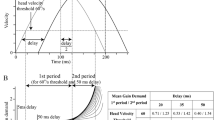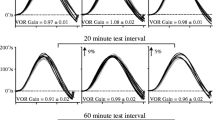Summary
In experimentally naive monkeys the horizontal vestibulo-ocular-reflex (VOR) has a time constant which is in the range of 40–60 s. It can be measured as the nystagmus decline after pulses of angular acceleration, or from the transfer functions obtained from sinusoidal rotation with different frequencies. When frequencies below 0.1 Hz are applied, sinusoidal rotation leads to a pronounced phase advance, a decrease in gain and a shortening of the pre- and post-rotatory nystagmus time constant. Even very low frequencies (e.g., 0.002 Hz) are effective where the phase advance of eye relative to head velocity is already 90 ° in the naive animal. Exposing the animal to stimulation only at a single frequency shifts the whole frequency curve towards a greater phase advance. These results are consistent with habituation experiments in which steps of angular velocity have repeatedly been applied. In these experiments nystagmus duration is shortened, whereas the initial response at the end of acceleration does not change. This corresponds to a phase shift and a gain reduction in the low frequency range (below 0.1 Hz) which we have also observed during sinusoidal rotation.
Similar content being viewed by others
References
Abels H (1906) Über Nachempfindung im Gebiete des kinästhetischen und statischen Sinnes. Ein Beitrag zur Lehre von Bewegungsschwindel (Drehschwindel). Z Psychol Physiol Sinnesorg 43: 268–289, 374–422
Aschan H (1954) Response to rotatory stimuli in fighter pilots. Acta Otolaryngol [Suppl] 116: 24–31
Blair S, Gavin M (1979) Response of the vestibulo-ocular reflex to differing programs of acceleration. Invest Ophthalmol Visual Sci 18: 1086–1090
Bond HW, Ho P (1970) Solid miniature silver-silverchloride electrodes for chronic implantations. Electroencephalogr Clin Neurophysiol 28: 206–208
Buettner UW, Büttner U, Henn V (1978) Transfer characteristics of neurons in vestibular nuclei of the alert monkey. J Neurophysiol 41: 1614–1638
Collins WE (1974) Habituation of vestibular responses with and without visual stimulation. In: Kornhuber HH (ed) Vestibular system. Springer, Berlin Heidelberg New York (Handbook of sensory physiology, vol VI/2, pp 369–388)
De Wit G (1953) Seasickness (motion sickness). A labyrinthological study. Acta Otolaryngol [Suppl] 108: 1–56
Fernandez C, Goldberg JM (1971) Physiology of peripheral neurons innervating semicircular canals of the squirrel monkey. II. Response to sinusoidal stimulation and dynamics of peripheral vestibular system. J Neurophysiol 34: 661–675
Gonshor A, Malcolm R (1971) Effect of changes in illumination level on electro-oculography (EOG). Aerosp Med 42: 138–140
Gonshor A, Melvill Jones G (1969) Investigations of habituation to rotational stimulation within the range of natural movement. Proceedings of the Aerospace Medical Association Meeting, San Francisco, pp 94–95
Gonshor A, Melvill Jones G (1976) Short-term adaptive changes in the human vestibulo-ocular reflex arc. J Physiol (Lond) 256: 361–379
Graybiel A, Knepton J (1978) Prevention of motion sickness in flight maneuvres, aided by transfer of adaptation effects acquired in the laboratory. Ten consecutive referais. Aviat Space Environ Med 49: 914–919
Hood JD, Pfaltz CR (1954) Observations upon the effects of repeated rotational and caloric nystagmus. J Physiol (Lond) 124: 130–144
Jeannerod M, Magnin M, Schmid R, Stefanelli M (1976) Vestibular habituation to angular velocity steps in the cat. Biol Cybern 22: 39–48
Kleinschmidt HJ, Collewijn H (1975) A search for habituation of vestibulo-ocular reactions to rotatory and linear sinusoidal acceleration in the rabbit. Exp Neurol 47: 257–267
Kris C (1958) Corneofundal potential variation during light and dark adaptation. Nature 182: 1027–1028
Osterhammel P, Terkildsen K, Zilstorff K (1970) Vestibular habituation in ballet dancers. Adv Otorhinolaryngol 17: 158–166
Raphan Th, Matsuo V, Cohen B (1979) Velocity storage in the vestibulo-ocular reflex arc (VOR). Exp Brain Res 35: 229–248
Young LR, Oman CM (1969) Model for vestibular adaptation in horizontal rotation. Aerosp Med 40: 1067–1080
Author information
Authors and Affiliations
Additional information
Supported by a grant from the Swiss National Foundation for Scientific Research 3.343-0.78
Rights and permissions
About this article
Cite this article
Jäger, J., Henn, V. Habituation of the vestibulo-ocular reflex (VOR) in the monkey during sinusoidal rotation in the dark. Exp Brain Res 41, 108–114 (1981). https://doi.org/10.1007/BF00236599
Received:
Issue Date:
DOI: https://doi.org/10.1007/BF00236599




